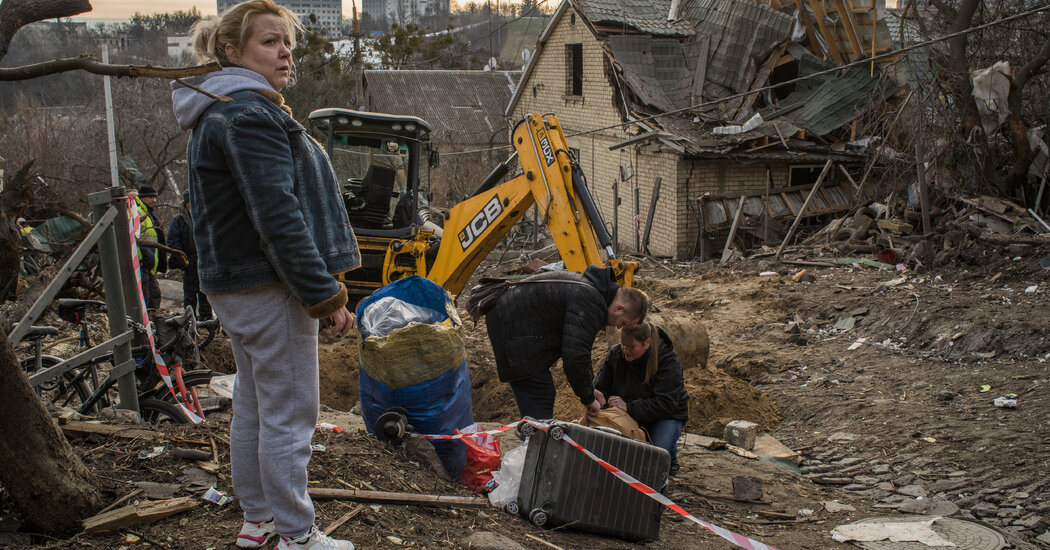Joke Honders had been up since 2:10 a.m. After months of waiting for approval from local Dutch officials, as well as for better weather, the time had come on Monday: An official team of experts would take its first, last and best shot at excavating a trove of treasures hidden by the Nazis.
Ms. Honders, a longtime resident and local historian, was in charge of the complex early-morning operation, which involved metal detectors, an excavator and a team of archaeologists, and she could not help but marvel at what was unfolding before her.
“This is exciting!” she said, coordinating the real-life treasure hunt in a grassy area next to an apple orchard in Ommeren, a sleepy village with about 750 residents that is 40 miles southeast of Amsterdam.
What it was not, it turned out, was successful.
Despite digging three separate holes within feet of each other — in an area that Ms. Honders had identified by overlaying ancient maps, modern maps and a hand-drawn map from a German soldier, and marked by little red flags — they had come up empty.
The fruitless morning brought an end to a monthslong pursuit that had enticed dozens of people with shovels and metal detectors to the tiny Dutch village in the hopes of unearthing four ammunition boxes loaded with stolen jewels, gold and watches.
The modern-day gold rush was touched off in January when a scheduled release of thousands of declassified documents from the Dutch National Archives brought to light the Nazi soldier’s map, drawn in 1945 and purportedly marking the location of an actual treasure.
Nazi soldiers had snatched the valuables, which are reputed to be worth millions, off the street after an explosion blew them out of a bank vault in the city of Arnhem in the late summer of 1944, documents from the archives show.
A couple of weeks before the end of the war, five German soldiers buried the treasure, but another, Helmut Sonder, watched them while lying in the bushes with a war injury.
He drew a map from memory, presumably with the idea of coming back for the spoils, according to the documents. The map prompted a hunt for the gold and jewels, to the dismay of some locals, and elevated the profile of Ommeren.
The map suggested a degree of precision — the treasure, it said, was buried about 1.7 to 2.3 feet deep, next to three poplar trees. But the trees are long gone, and the location has remained as mysterious as ever.
The search led by Ms. Honders, who also works at a regional museum, represented the only formal effort to find what had been left behind. The Buren municipality, which includes Ommeren, turned away several requests for similar endeavors, according to Pieter Neven, an official there. Ms. Honders’s foray was approved, he said, because “We wanted to handle it professionally.”
Mr. Neven said that the municipality had subsidized Ms. Honders’s search with 2,000 euros, about $2,200, to help pay for the archaeologists and professional metal-detector operators.
On Monday morning, Ms. Honders and the other searchers were careful not to set expectations too high. “It’s like searching for a needle in a haystack,” said Jan van Renswoude, an archaeologist who helped search for the treasure.
Still, the anticipation was almost palpable as the sound of a beeping metal detector and the low hum of an excavator were heard. As the beeps grew louder, the gathering grew quieter.
With the prospects for glory dwindling, Ms. Honders declared, “I still have hope.”
But the lack of treasure wasn’t much of a surprise. “I didn’t expect anything,” said Arie Krijgsman, who has lived in Ommeren for 15 years, as he was walking his dog. He said that the search was, if nothing else, entertaining. “It has made me laugh,” Mr. Krijgsman said. “It was a little bit like a gold rush.”
No treasure came out of the ground, but the archaeologists unearthed a few things for their trouble: An unused 9 millimeter World War II-era bullet, some scrap metal and iron wire.
“It’s a meager harvest,” said Klaas Tammes, a local resident and a former mayor of the municipality that includes Ommeren. “The mystery of the treasure will stay intact,” he added.
The village has been the site of archaeological buzz before. In 2016, three searchers found a trove of 31 golden Roman coins. But the chances of finding the Nazi treasure were infinitesimal, experts agreed; it could well have been dug up decades ago.
After roughly four hours of searching and digging, the sun broke through the clouds and the archaeologists turned off the excavator, ending the search for good. Mr. Neven said this would be the last time the municipality would approve a request to search for the Nazi treasure, although it’s not clear whether the amateur treasure hunters who found Ommeren an inviting target will be dissuaded.
Ms. Honders seemed at peace with the result. “It’s not here,” she said, but one thing had come out of the experience. “Tonight I’ll be able to sleep again.”
Source : Nytimes














